Gaudi in 2016
2016/07/25 created
2021/05/07 updated
The contents of this page were reprinted from the previous homepage of mine, 'Tonochi's Audio Room'. Some parts were edited.
I have been developing my audio system Gaudi since 1974. In September 2015,
it was completed at last, as the midrange amplifier MA-215 Arabesque was completed.
I determined the completion of Gaudi though it is a bit different from
the original system design (the preamplifier and all the power amplifiers
were tubed type), because all the amplifiers used in Gaudi are my works
now and the sound quality (SQ) has reached at the level that I aimed at
in the first place.
Another major difference is the digital player. I replaced the SACD/CD player, SONY SCD-555ES, with an HDD player, SONY HAP-Z1ES. I think optical discs like CD and SACD are old-fashioned now in all aspects such as SQ, usability and cost.
The configuration of Gaudi has turned to be as shown in the diagram below:
[Block diagram]
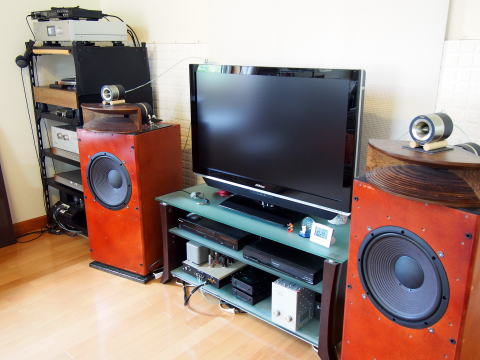
The power amplifier MA-215 Arabesque lives up to my expectation. It improved
SQ of Gaudi further, and its musicality is so good.
However, I know Arabesque has some shortcomings to improve from the results
of measurements and listening tests (for detailed information, see the
page of Arabesque). It's a natural consequence because Arabesque is my first solid state
power amplifier.
As for SQ of Gaudi, I've expressed it by the wording "nearly high
end" in this website for recent years, but now I am convinced that
difference between "nearly high end" and "truly high end"
is so big. Say, every time a shortcoming is removed, another one appears
soon. I believe Gaudi still has some challenges to solve in order to realize
truly high end SQ.
I'm planning to analyze the shortcomings of Gaudi and design Gaudi II based
on the analysis. I believe my dream will come true with Gaudi II.
HAP-Z1ES (HAP) didn't live up to my expectation. Before evaluating its SQ, I was
annoyed by its mechanical noises produced by the cooling fan and HDD. I
had never heard of an audio device that produces a mechanical noise. And
the list price of HAP is as expensive as 210,000 JPY. I owned two other
A/V devices (digital recorder: KORG MR-2000S, STB: Panasonic TZ-HDW611P),
and they don't produce any mechanical noise. The HAP is my fifth one in
Sony's ES series, and I was happy with the previous four. It was the first
time I was disappointed with the ES series.
I was surprised when I saw the inside of HAP. The HDD is 2.5 inch type,
instead of 3.5 inch silent type. The fan is not silent type either. The
layout looked like one for IT equipment. I can't believe it was designed
by (an) audio engineer(s). Maybe, (an) IT engineer(s) did.
I was not aware of this problem when I auditioned it at an audio shop,
because of the ambient noise. My house is located in a quiet residential
area and has good acoustic insulation, so it is quiet in the room at even
a day time. The mechanical noise from HAP can be heard at any place in
the room.
Before I bought HAP, I check out user reviews on Internet. Almost all the
reviewers gave it five stars and no one reported this problem. Besides,
some audio magazines recommended HAP. So I didn't expect this problem.
I quit using KORG MR-2000S as a digital player. I use it only when I digitally
record vinyl discs. HAP is better in SQ than MR-2000S even though it has
the noise problem. Besides, a smart phone can be used as a remote of HAP
with an APP (HDD Audio Remote). So HAP is much better in usability.
I confirmed the effect of DSEE, Sony's proprietary technology to upgrade
lower bit rate music files. When a CD quality WAV file is played with DSEE
activated, it nearly sounds like a vinyl record. Especially, in case that
the original recording is analog, DSEE is more effective.
The mechanical noises aside, HAP has good SQ. I would like to replace the
HDD with a SSD for silent operation in some day in the near future.
I am considering replacement of the analog disc player too. At the beginning of this year (2016), I bought Pioneer PLX-1000 and have been testing it till now (July). I admit it excels my old player PS-104 in both SQ and usability, but I stick to PS-104, which I built when I was a university student and have used for the past 34 years. I can hardly abandon it.
One more change. I replaced the PC and the player program to improve SQ
of PC-based audio.
The new PC is Panasonic Let's Note. Its CPU is Core i5. It is so powerful
for a small laptop PC.
The player program Audio Gate is upgraded from the Ver. 3 to Ver. 4. The
Audio Gate 4 needs a powerful CPU. It causes an error on my previous PC,
Lenovo ThinkPad. It runs on Let's Note without any problem.
SQ is much better. It is close to that of HAP. I felt again high performance
of KORG DS-DAC-10.
However, Let's Note causes mechanical noises of the fan and HDD. It is
a catch for listening to music. I think the problem will be solved by replacing
the HDD with SSD.
Equipment
| Category | Model | Features | Description |
|---|---|---|---|
| ADP | 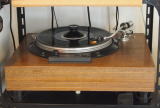 NOBODY PS-104 NOBODY PS-104 |
*Turntable: SONY TTS-8000 *Tone arm: GRACE G-1040 *Cartridge: audio-technica AT33PTG/II |
I've been using it w/o major modification since 1982. I changed the cartridge from MM type to MC type in 2014. I am considering replacing it with Pioneer PLX-1000. |
| MC head amp |  NOBODY HA-213 NOBODY HA-213 |
Head amplifier for MC cartridges Gain = 30dB |
This amplifier was designed as a headphone amplifier at first. Before completion, it was re-designed as the MC head amplifier. Though its design is not perfect, a certain level of sound quality has been achieved. |
| DAP | SONY HAP-Z1ES | HDD player w/ built-in 1TB HDD |
PCM: up to 192kHz/24bit DSD: up to 5.6MHz I bought and installed it in 2015. |
| DAP | Panasonic Let's Note CF-N9 |
11" laptop PC | Storage: 250GB SSD. The combination of this PC and DS-DAC-10 functions as digital audio player. It also functions as a measurement instrument w/PicoScope and PAA3. |
| DAP | KORG DS-DAC-10 | USB DAC | The combination of this device and Let's Note functions as digital audio player. The player program is Audio Gate 4. |
| DAR | KORG MR-2000S-BK | 1-bit digital recorder | Digital recorder for studio use. It is also available in the retail market.
The highest resolution is PCM 192kHz/24bit and DSD 5.6MHz. It is used for recording vinyl discs. |
| Preamp |  NOBODY PA-210 Simplicity NOBODY PA-210 Simplicity |
Tube preamplifier All stages are SRPP CR-type phono equalizer Non-NFB flat stage Separate power supply |
A tube preamp made in 2001-2003. Featured by out-and-out simplicity and low noise. |
| Network |  NOBODY CD-211B A-NET NOBODY CD-211B A-NET |
Solid state Three-way channel divider (network) |
The first NOBODY-branded model that uses op amps. Made in 2004. Rev. A
in 2012. Rev. B in 2015. Crossover frequencies: 800Hz(18dB/oct), 6800Hz(18dB/oct) |
| Tweeter amp | 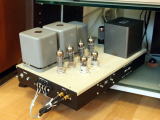 NOBODY MA-208 NOBODY MA-208 |
Tube power amplifier 6BQ5 UL PP |
Designed for horn-loaded tweeters. Made in 1999. Split load phase splitter; rectifying tube. Output power: 10W+10W |
| Midrange amp | 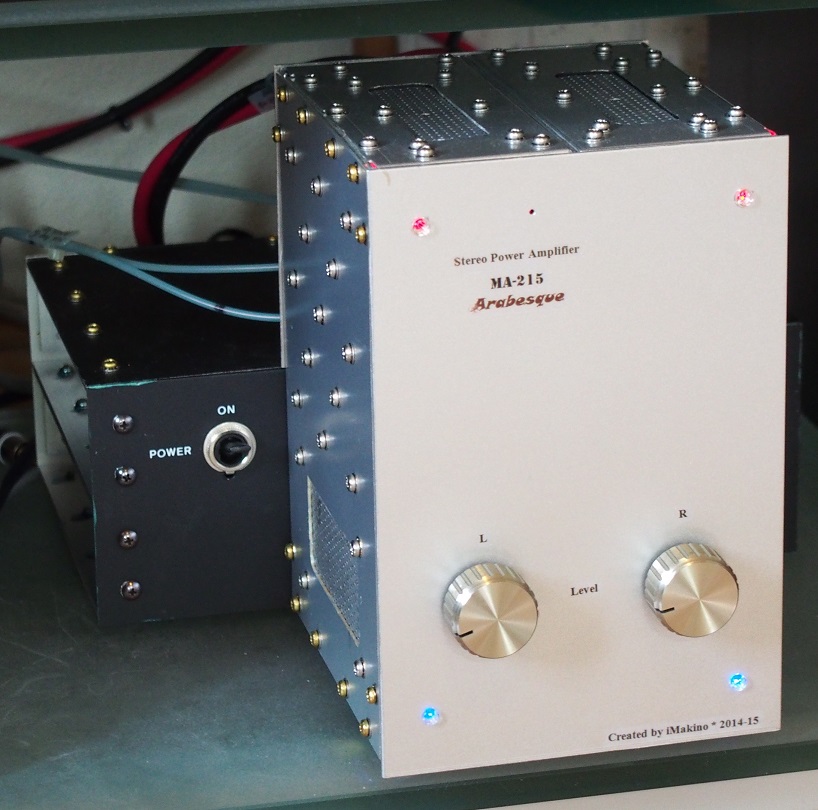 NOBODY MA-215 Arabesque NOBODY MA-215 Arabesque |
Chip power amplifier IC: LM3886 |
Power amp for midrange, made in 2015. Its sound is clear and transparent, with very low output impedance. Output power: 1W+1W (8ohm) |
| Woofer amp | Tube power amplifier 6CA7 UL PP |
The first NOBODY-branded equipment, made in 1974. Used for woofers. The current revision: C Output power: 30W+30W | |
| Loudspeaker | 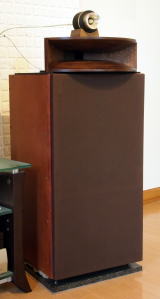 NOBODY SS-309A NOBODY SS-309A |
Three-way speaker system *Tweeter: Fostex T925A *Midrange: Fostex D1405+H400 *Woofer: Fostex FW305 |
12" woofer-based three-way loudspeaker, made in 2001. It doesn't include network and attenuator since it's designed for the multi-amplifier system. Vented box for woofer. The midrange unit was changed from full-range direct radiator to horn-loaded midrange in 2012 (Rev. A). |
| Pnono cable | PS-104 -> PA-210 | GRACE genuine cable (RCA plugs has been replaced) |
Low capacitance cable using LC-OFC. In 2011, the RCA plugs' solder joints corroded and the cable was disconnected. The RCA plugs were replaced with new ones using PTFE insulator. Sound quality has been a bit improved. |
| Line cable | HAP-Z1ES -> PA-210 | Handmade cable *Wire: BELDEN 8412 *Plug: Teflon RCA plug |
Handmade cable made of balanced type shield wire. Though the RCA plug is
a generic one, the insulator material is teflon. The plug's metal cover is not attached. Shrink tube is applied instead. |
| Line cable | PA-210 -> CD-211B | Handmade cable *Wire: BELDEN 8412 *Plug: Teflon RCA plug |
Handmade cable composed of balanced type shield wires. One end of the cable is soldered in CD-211B. |
| Line cable | CD-211B -> MA-208 | Handmade cable *Wire: BELDEN 8412 *Plug: Teflon RCA plug |
Handmade cable composed of balanced type shield wires. One end of the cable
is soldered in CD-211B. The wires were Audio Technica AT6A48 when CD-211 was built (2004). They were replaced with BELDEN 8412 in 2008. BELDEN is unquestionably superior. The metallic cover of the plug was replaced with a thermal shrink tube. |
| Line cable | CD-211B -> MA-215 | Handmade cable *Wire: NEGLEX 2549 *Plug: Teflon RCA plug |
Handmade cable composed of balanced type shield wires. One end of the cable is soldered in CD-211B. |
| Line cable | CD-211B -> MA-201C | Handmade cable *Wire: BELDEN 8412 *Teflon RCA plug |
Handmade cable composed of balanced type shield wires. One end of the cable is soldered in CD-211B. |
| Speaker cable | MA-208 -> SS-309A tweeter | Handmade cable *Wire: 47 Laboratory STRATOS *Plug: none |
Handmade cable made of 0.4mm copper single wires twisted at 30cm pitch. One end of the cable is soldered to the output terminal of MA-208. The other end is plated w/ silver loaded solder. |
| Speaker cable | MA-215 -> SS-309A midrange | Handmade cable *Wire: audio- technica AT365S *Plug: none |
Handmade cable made of Audio Technica's entry class OFC wire. The both ends have no connector and coated with Titan Audio Oil. |
| Speaker cable | MA-201C -> SS-309A woofer | Handmade cable *Wire: 47 Laboratory STRATOS *Plug: none |
Handmade cable made of 0.6mm copper single wires twisted at 30cm pitch. One end of the cable is soldered to the output terminal of MA-201C. The other end is directly soldered to the terminal of woofer. |
| Room | 25m2 living room | Fairly soundproofed. Slightly live at mid and high frequencies and slightly dead at low frequencies. Almost no standing waves thanks to the slant ceiling. Acoustics is tuned by using acoustic panels, sound absorbing panels and sound absorbing curtain. Equipped with outlets for audio equipment; both 100V and 200V. The sockets are for medical use. |